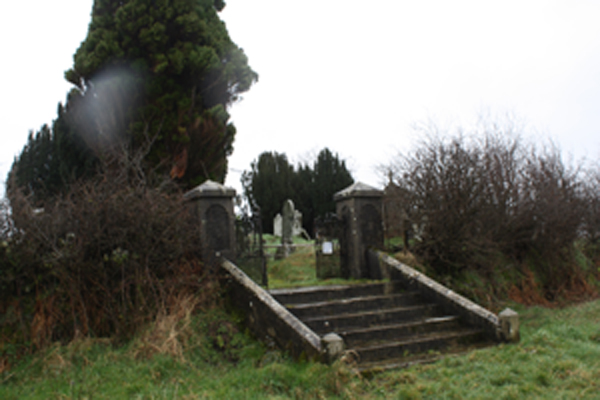There are no signs directing visitors to Tullyrusk graveyard which sits in the expanse of fields beyond the Ballymac Hotel. And there isn’t even a road to it. This graveyard is a precious relic of old Ireland that has been forgotten by all except those whose relatives lie there.
Dúlra only learned about it from a reader who had happened upon the cemetery while out for a walk. The reader had mentioned that there were yew trees in the graveyard, and it was those trees that finally caught Dúlra’s eye or he wouldn’t have found it at all.
And so he walked through a farmer’s gate towards a circular mound in the distance that is raised above the surrounding rolling fields that sweep down towards Lough Neagh, up the stone steps and in through the double iron gates. And what Dúlra found was a beautiful, remote, wild resting place with stunning views over much of Ulster.
It’s a graveyard from the mists of time. In ancient days it was a church whose name has long been forgotten which was reputedly founded by St Patrick. A thousand years later it was demolished by Cromwell. The foundations of the church are still visible, along with a holy well nearby.
Indeed, the church at Tullyrusk was so famous it got got name-checked in story written in Armagh way back in the 700s.
The gravestones reveal a mixed clientele – Catholics and Protestants made equal by the Great Leveller. Simply known today after the townland Tulaigh Ruisc, the hillock of the march, the oldest legible gravestone inscription dates from 1720 (63-year-old Elizabeth Waters). The most recent, as Dúlra was soon to discover, was last Friday on the day of his visit, a poignant reminder that in Ireland, history and the present day are rarely separated.
A century ago cultural activist Francis Joseph Bigger called Tullyrusk the “last of the old burial places left to the ancient stock”, and said that a hundred years previously, the old Irish keening would wail around the crumbling walls during funerals. Some say it can still be heard in the wind after the burial of the old clans, he wrote.
But the grave of one heroic resident of Tullyrusk remains unmarked. A local man called Armstrong was condemned to hang in Lisburn in 1798 after messages from the United Irishmen were found sewn into the lining of his waistcoat. As he awaited the gallows, his wife and children were allowed to see him, begging him to save his life by turning in his comrades.
“Do not tempt me, mo chroí,” he told her. “My life is only one, and God will watch over my widow and children.” If I inform, he said, many “wives would be made widows and hundreds of children left fatherless”.
As Dúlra walked through the small graveyard, its ground uneven due to the multiple burials over centuries, he thought of the distraught widow burying her husband that summer’s day in 1798, her children gathered around her. There could have been few sadder sights in the tragic history of this land.
Dúlra was making his way around the old gravestones, doing his best to decipher them, when a gravedigger arrived. “This graveyard is rarely used for funerals nowadays,” he said. “I’m called here once a year at the most.”
Dúlra left before the funeral cortege arrived – access is through a nearby bungalow and the coffin is usually carried across the fields amid the glorious backdrop as has been done for countless centuries.
Dúlra could not think of a better place to lie, below the beautiful yew trees in one of the country's most unique and historic resting places.
A place apart, overlooking Lough Neagh and beyond, and alongside countless generations of a proud people.
* If you’ve seen or photographed anything interesting, or have any nature questions, you can text Dúlra on 07801 414804.






